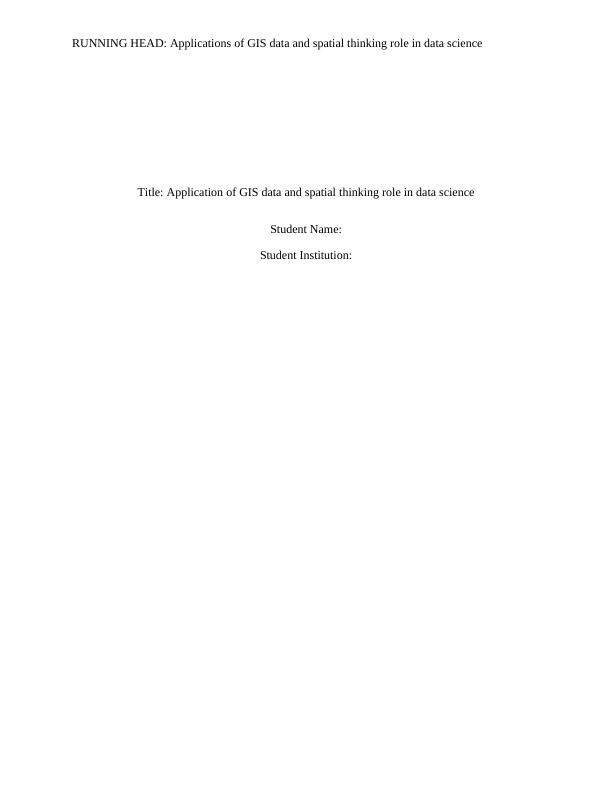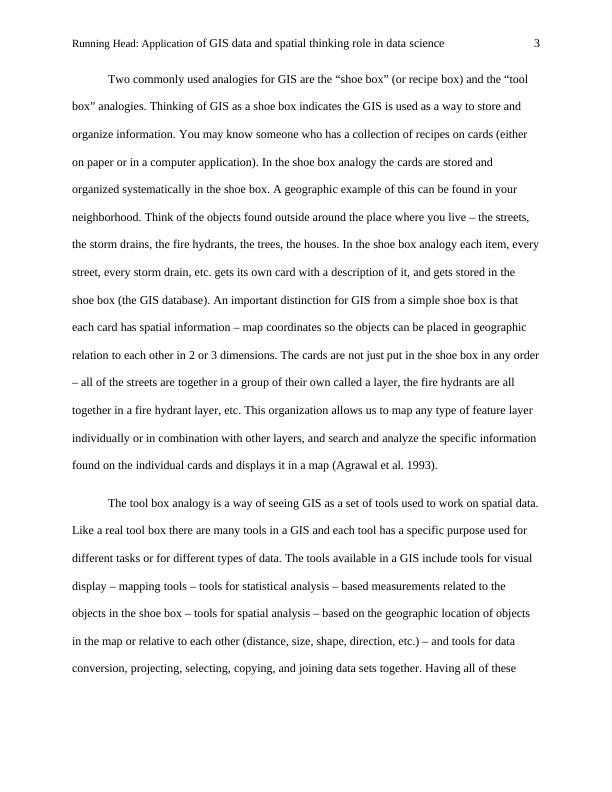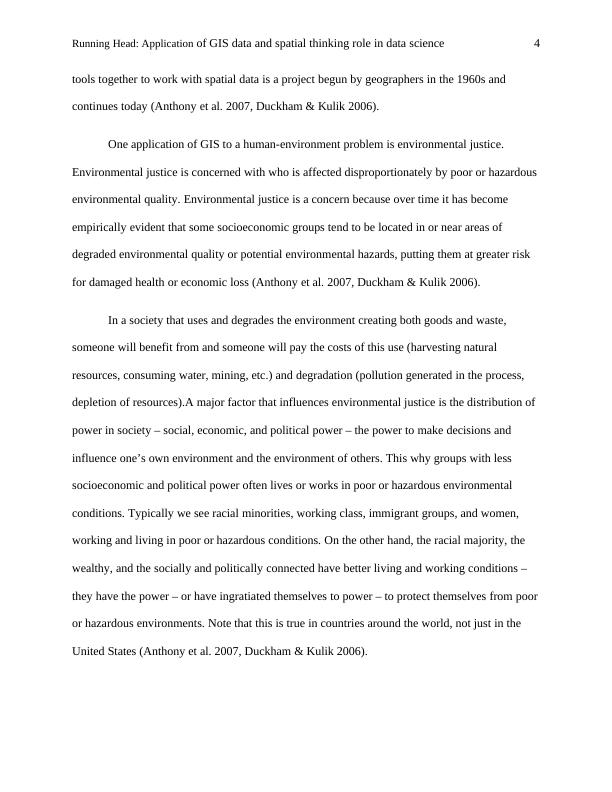Geospatial Analytics Use cases - Assignment
An evaluation of GIS applications in Computer Science and Data Science, focusing on the use of spatial data from multiple sources and establishing a framework for data reliability in a 'fit-for-purpose' context.
13 Pages3869 Words18 Views
Added on 2022-09-06
Geospatial Analytics Use cases - Assignment
An evaluation of GIS applications in Computer Science and Data Science, focusing on the use of spatial data from multiple sources and establishing a framework for data reliability in a 'fit-for-purpose' context.
Added on 2022-09-06
ShareRelated Documents
RUNNING HEAD: Applications of GIS data and spatial thinking role in data science
Title: Application of GIS data and spatial thinking role in data science
Student Name:
Student Institution:
Title: Application of GIS data and spatial thinking role in data science
Student Name:
Student Institution:

Running Head: Application of GIS data and spatial thinking role in data science 2
Abstract
This report examines the strengths and weaknesses of currently available off-the-shelf
versions of GIS as a learning environment. In making its judgment on the design and
implementation of GIS as a support system for spatial thinking in the data science environment,
the committee relies on primarily oral presentations and written statements from system
designers, researchers, and school and university educators.
Introduction
Geographers use GIS (Geographic Information System) to document, study, and
communicate information about a wide array of things we find all around us every day. In this
lab we will explore how GIS is used to study questions of environmental justice. GIS are used by
businesses (Google, Microsoft, Amazon, UPS, CVS, and on and on), local government agencies
(City of Omaha, Omaha Metro, OPPD, Omaha MUD, etc.), federal agencies (US Department of
Agriculture, US Forest Service, US Geological Survey, US Fish and Wildlife Service, Census
Bureau, etc.), and scientists and academics doing social and environmental research. Developing
techniques, tools, and expert application of GIS for the groups listed above are specializations
within the field of Geography.
Information analysis and Data synthesis
GIS are powerful tools for collecting, storing, organizing, doing statistical analysis, doing
spatial analysis, reporting, visualizing, and mapping spatial data. Spatial data are any data that
can be associated with specific places – locations. For instance home prices in a neighborhood –
with GIS not only can you make a map of where homes are, but you can do an analysis of how
home prices vary with distances from schools, parks, or restaurants (Agrawal et al. 1993).
Abstract
This report examines the strengths and weaknesses of currently available off-the-shelf
versions of GIS as a learning environment. In making its judgment on the design and
implementation of GIS as a support system for spatial thinking in the data science environment,
the committee relies on primarily oral presentations and written statements from system
designers, researchers, and school and university educators.
Introduction
Geographers use GIS (Geographic Information System) to document, study, and
communicate information about a wide array of things we find all around us every day. In this
lab we will explore how GIS is used to study questions of environmental justice. GIS are used by
businesses (Google, Microsoft, Amazon, UPS, CVS, and on and on), local government agencies
(City of Omaha, Omaha Metro, OPPD, Omaha MUD, etc.), federal agencies (US Department of
Agriculture, US Forest Service, US Geological Survey, US Fish and Wildlife Service, Census
Bureau, etc.), and scientists and academics doing social and environmental research. Developing
techniques, tools, and expert application of GIS for the groups listed above are specializations
within the field of Geography.
Information analysis and Data synthesis
GIS are powerful tools for collecting, storing, organizing, doing statistical analysis, doing
spatial analysis, reporting, visualizing, and mapping spatial data. Spatial data are any data that
can be associated with specific places – locations. For instance home prices in a neighborhood –
with GIS not only can you make a map of where homes are, but you can do an analysis of how
home prices vary with distances from schools, parks, or restaurants (Agrawal et al. 1993).

Running Head: Application of GIS data and spatial thinking role in data science 3
Two commonly used analogies for GIS are the “shoe box” (or recipe box) and the “tool
box” analogies. Thinking of GIS as a shoe box indicates the GIS is used as a way to store and
organize information. You may know someone who has a collection of recipes on cards (either
on paper or in a computer application). In the shoe box analogy the cards are stored and
organized systematically in the shoe box. A geographic example of this can be found in your
neighborhood. Think of the objects found outside around the place where you live – the streets,
the storm drains, the fire hydrants, the trees, the houses. In the shoe box analogy each item, every
street, every storm drain, etc. gets its own card with a description of it, and gets stored in the
shoe box (the GIS database). An important distinction for GIS from a simple shoe box is that
each card has spatial information – map coordinates so the objects can be placed in geographic
relation to each other in 2 or 3 dimensions. The cards are not just put in the shoe box in any order
– all of the streets are together in a group of their own called a layer, the fire hydrants are all
together in a fire hydrant layer, etc. This organization allows us to map any type of feature layer
individually or in combination with other layers, and search and analyze the specific information
found on the individual cards and displays it in a map (Agrawal et al. 1993).
The tool box analogy is a way of seeing GIS as a set of tools used to work on spatial data.
Like a real tool box there are many tools in a GIS and each tool has a specific purpose used for
different tasks or for different types of data. The tools available in a GIS include tools for visual
display – mapping tools – tools for statistical analysis – based measurements related to the
objects in the shoe box – tools for spatial analysis – based on the geographic location of objects
in the map or relative to each other (distance, size, shape, direction, etc.) – and tools for data
conversion, projecting, selecting, copying, and joining data sets together. Having all of these
Two commonly used analogies for GIS are the “shoe box” (or recipe box) and the “tool
box” analogies. Thinking of GIS as a shoe box indicates the GIS is used as a way to store and
organize information. You may know someone who has a collection of recipes on cards (either
on paper or in a computer application). In the shoe box analogy the cards are stored and
organized systematically in the shoe box. A geographic example of this can be found in your
neighborhood. Think of the objects found outside around the place where you live – the streets,
the storm drains, the fire hydrants, the trees, the houses. In the shoe box analogy each item, every
street, every storm drain, etc. gets its own card with a description of it, and gets stored in the
shoe box (the GIS database). An important distinction for GIS from a simple shoe box is that
each card has spatial information – map coordinates so the objects can be placed in geographic
relation to each other in 2 or 3 dimensions. The cards are not just put in the shoe box in any order
– all of the streets are together in a group of their own called a layer, the fire hydrants are all
together in a fire hydrant layer, etc. This organization allows us to map any type of feature layer
individually or in combination with other layers, and search and analyze the specific information
found on the individual cards and displays it in a map (Agrawal et al. 1993).
The tool box analogy is a way of seeing GIS as a set of tools used to work on spatial data.
Like a real tool box there are many tools in a GIS and each tool has a specific purpose used for
different tasks or for different types of data. The tools available in a GIS include tools for visual
display – mapping tools – tools for statistical analysis – based measurements related to the
objects in the shoe box – tools for spatial analysis – based on the geographic location of objects
in the map or relative to each other (distance, size, shape, direction, etc.) – and tools for data
conversion, projecting, selecting, copying, and joining data sets together. Having all of these

Running Head: Application of GIS data and spatial thinking role in data science 4
tools together to work with spatial data is a project begun by geographers in the 1960s and
continues today (Anthony et al. 2007, Duckham & Kulik 2006).
One application of GIS to a human-environment problem is environmental justice.
Environmental justice is concerned with who is affected disproportionately by poor or hazardous
environmental quality. Environmental justice is a concern because over time it has become
empirically evident that some socioeconomic groups tend to be located in or near areas of
degraded environmental quality or potential environmental hazards, putting them at greater risk
for damaged health or economic loss (Anthony et al. 2007, Duckham & Kulik 2006).
In a society that uses and degrades the environment creating both goods and waste,
someone will benefit from and someone will pay the costs of this use (harvesting natural
resources, consuming water, mining, etc.) and degradation (pollution generated in the process,
depletion of resources).A major factor that influences environmental justice is the distribution of
power in society – social, economic, and political power – the power to make decisions and
influence one’s own environment and the environment of others. This why groups with less
socioeconomic and political power often lives or works in poor or hazardous environmental
conditions. Typically we see racial minorities, working class, immigrant groups, and women,
working and living in poor or hazardous conditions. On the other hand, the racial majority, the
wealthy, and the socially and politically connected have better living and working conditions –
they have the power – or have ingratiated themselves to power – to protect themselves from poor
or hazardous environments. Note that this is true in countries around the world, not just in the
United States (Anthony et al. 2007, Duckham & Kulik 2006).
tools together to work with spatial data is a project begun by geographers in the 1960s and
continues today (Anthony et al. 2007, Duckham & Kulik 2006).
One application of GIS to a human-environment problem is environmental justice.
Environmental justice is concerned with who is affected disproportionately by poor or hazardous
environmental quality. Environmental justice is a concern because over time it has become
empirically evident that some socioeconomic groups tend to be located in or near areas of
degraded environmental quality or potential environmental hazards, putting them at greater risk
for damaged health or economic loss (Anthony et al. 2007, Duckham & Kulik 2006).
In a society that uses and degrades the environment creating both goods and waste,
someone will benefit from and someone will pay the costs of this use (harvesting natural
resources, consuming water, mining, etc.) and degradation (pollution generated in the process,
depletion of resources).A major factor that influences environmental justice is the distribution of
power in society – social, economic, and political power – the power to make decisions and
influence one’s own environment and the environment of others. This why groups with less
socioeconomic and political power often lives or works in poor or hazardous environmental
conditions. Typically we see racial minorities, working class, immigrant groups, and women,
working and living in poor or hazardous conditions. On the other hand, the racial majority, the
wealthy, and the socially and politically connected have better living and working conditions –
they have the power – or have ingratiated themselves to power – to protect themselves from poor
or hazardous environments. Note that this is true in countries around the world, not just in the
United States (Anthony et al. 2007, Duckham & Kulik 2006).

End of preview
Want to access all the pages? Upload your documents or become a member.
